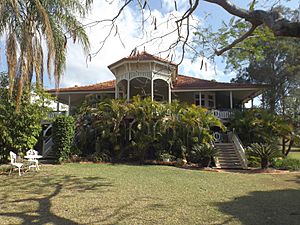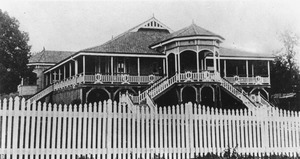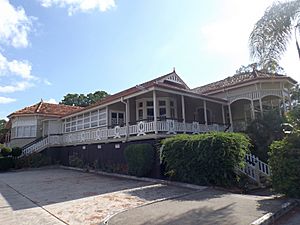Ipswich Club House facts for kids
Quick facts for kids Ipswich Club House |
|
|---|---|

Front of the building, 2015
|
|
| Location | 14 Gray Street, Ipswich, City of Ipswich, Queensland, Australia |
| Design period | 1900 - 1914 (early 20th century) |
| Built | c. 1915 - 1916 |
| Architect | George Brockwell Gill |
| Official name: Ipswich Club House | |
| Type | state heritage (built, landscape) |
| Designated | 21 August 1992 |
| Reference no. | 600581 |
| Significant period | 1910s - (fabric, historical) 1959 - (social) |
| Significant components | garden/grounds, basement / sub-floor, residential accommodation - main house, staircase/stairs - divided |
| Lua error in Module:Location_map at line 420: attempt to index field 'wikibase' (a nil value). | |
The Ipswich Club House is a really old and grand timber house located at 14 Gray Street in Ipswich, Queensland, Australia. It was designed by a famous architect named George Brockwell Gill and was built around 1915-1916. Today, it's a special heritage-listed building, which means it's protected because of its history and unique design. It's now home to the Ipswich Club, a place where people gather for social events.
Contents
A Look Back in Time
The Bottomley Family Home
The Ipswich Club House, a big two-storey timber building, was originally built as a family home in 1916. It was commissioned by J.P. Bottomley, a successful butcher and landowner from Ipswich. He named his new home 'Tydfil'. Records show that a new house was on the property by March 1916.
J.P. Bottomley was born in England and moved to Ipswich, Australia, in 1884. He started as a butcher and later owned his own business. He also bought large areas of land for farming. Bottomley became a very important person in Ipswich. He served on the local council for many years, even as chairman. He was also president of several community groups, like the Ipswich Show Society and the Ipswich Bowling Club.
The Architect: George Brockwell Gill
The house was designed by George Brockwell Gill, a well-known architect in Ipswich. He designed many grand homes and public buildings in the area from the 1880s to the 1930s. Some of his other famous works include the Ipswich Girls' Grammar School and the Ipswich Technical College.
Gill moved to Ipswich from London in 1886 and started working as an architect. He took over his boss's business in 1889. He was a respected member of the Queensland Institute of Architects, even serving as its president. Although Bottomley bought the land in 1898, the house wasn't built until 1916.
From Family Home to Club House
The 'Tydfil' house stayed with the Bottomley family until 1959. That year, the Ipswich Club bought it. The Ipswich Club had opened in 1949, and this new house became its official home in 1960. In J.P. Bottomley's time, the house was often used for community events. Today, as the Ipswich Club, it continues to be a place for social gatherings.
The building has changed quite a bit inside since it became the Ipswich Club. For example, a bar was added, and one of the verandahs (an open porch area) was enclosed to become a restaurant. The back part of the building was also extended to create a large space for events. However, many of the beautiful original ceilings and wooden details in the main hall are still there.
What Does It Look Like?
The Ipswich Club House is a large, tall timber house built on wooden stumps. It was constructed during the "Federation era," a time when Australia became a nation. When you look at it from the street, you'll notice its impressive front. It has a unique octagonal (eight-sided) porch right in the middle, with stairs leading up to it. This octagonal porch is a special design feature that architect George Brockwell Gill used in some of his other houses too.
Another similar porch on the side of the building is now partly hidden by later additions. The house has a roof made of terracotta tiles, which extends over the verandahs on three sides. You can also see decorative terracotta pieces on the roof.
A really cool part of the house is the fancy wooden work on the verandahs. The railings are made of wide, white wooden slats, and each section has a circular design in the middle. There's also a decorative scalloped border made from wide, white slats. Dark wooden panels cover the stumps supporting the house. Under the main octagonal porch, there's a large, arch-shaped white wooden piece, almost like a giant decorative bracket. These unusual wooden details were typical of George Brockwell Gill's designs. The house sits back from the street, and tall plants frame the view, making it look even more grand.
Why Is It Special?
The Ipswich Club House was added to the Queensland Heritage Register on 21 August 1992. This means it's considered an important historical place for several reasons:
- It shows how Queensland's history developed.
The Ipswich Club building helps us understand how wealthy people in Ipswich built grand homes in the early 1900s. These homes were a way for them to show off their success and wealth.
- It has great aesthetic significance.
The former residence is beautiful to look at. Its grand appearance on Gray Street, with its detailed timber work and large, old gardens, makes it very special.
- It has a strong connection to the community.
The club house is important to the local community because of its role in the city's business and social life as the Ipswich Club. It has been a place for people to gather for many years.
- It's linked to important people or groups in Queensland's history.
The Ipswich Club House is a great example of architect George Brockwell Gill's work, especially his unique timber designs. Gill created many important buildings in Ipswich. The house is also strongly connected to J.P. Bottomley, the important Ipswich citizen for whom it was built in 1916.



